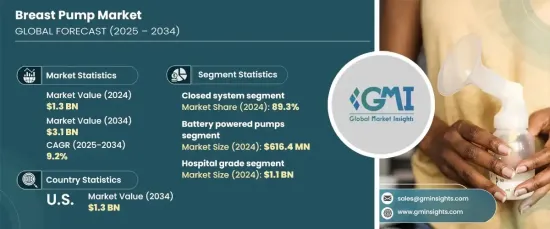PUBLISHER: Global Market Insights Inc. | PRODUCT CODE: 1666615

PUBLISHER: Global Market Insights Inc. | PRODUCT CODE: 1666615
Breast Pump Market Opportunity, Growth Drivers, Industry Trend Analysis, and Forecast 2025 - 2034
The Global Breast Pump Market, valued at USD 1.3 billion in 2024, is set to grow at a 9.2% CAGR from 2025 to 2034. Breast pumps are devices used by lactating individuals to express milk, offering flexibility for working mothers or those separated from their babies. The demand for these pumps has surged, particularly due to the rising number of women returning to the workforce soon after childbirth. These devices support women in balancing work and breastfeeding, making them a vital tool in many households.

Advances in technology, such as quieter motors and increased comfort, have further boosted the market, making breast pumps more practical and easier to use. Additionally, growing awareness about breastfeeding's health benefits and the role of accessories like breast pumps in supporting breastfeeding has driven further market expansion. As more people become conscious of the importance of breastfeeding, the adoption of breast pumps has risen, particularly among health-conscious consumers who prioritize hygiene and comfort.
| Market Scope | |
|---|---|
| Start Year | 2024 |
| Forecast Year | 2025-2034 |
| Start Value | $1.3 Billion |
| Forecast Value | $3.1 Billion |
| CAGR | 9.2% |
In terms of product types, the breast pump market is divided into open and closed systems. Closed-system pumps, which prevent milk from contaminating the pump mechanism, dominate the market, capturing 89.3% of the total revenue in 2024. These pumps are highly valued for their hygienic features, making them ideal for multiple users. The continuous innovation in closed-system pumps, such as improved suction control and quieter operations, is encouraging more consumers to opt for these products.
The breast pump market is also segmented by technology into manual, battery-powered, and electric pumps. Battery-powered pumps hold the largest market share, reaching USD 616.4 million in 2024. These pumps are portable and convenient, making them especially useful for mothers who need to express milk while away from home. The growth of this segment is driven by the increasing number of women returning to work soon after childbirth. Recent improvements in battery-powered pump designs, such as quieter motors and more compact sizes, have made them more attractive to consumers.
Regarding application, breast pumps are classified into personal use and hospital-grade models. The hospital-grade pumps segment leads the market, with a revenue of USD 1.1 billion in 2024. These pumps are essential in neonatal intensive care units, where they support mothers of preterm infants in achieving sufficient milk production. Hospital-grade pumps are recognized for their efficiency, comfort, and ability to express larger milk volumes quickly, making them a crucial resource in healthcare settings.
The U.S. breast pump market is expected to see significant growth, driven by policies such as the Affordable Care Act (ACA), which has expanded access to these devices through insurance coverage. This policy has made breast pumps more accessible to new mothers, contributing to their growing use in the U.S.
Table of Contents
Chapter 1 Methodology and Scope
- 1.1 Market scope and definitions
- 1.2 Research design
- 1.2.1 Research approach
- 1.2.2 Data collection methods
- 1.3 Base estimates and calculations
- 1.3.1 Base year calculation
- 1.3.2 Key trends for market estimation
- 1.4 Forecast model
- 1.5 Primary research and validation
- 1.5.1 Primary sources
- 1.5.2 Data mining sources
Chapter 2 Executive Summary
- 2.1 Industry 3600 synopsis
Chapter 3 Industry Insights
- 3.1 Industry ecosystem analysis
- 3.2 Industry impact forces
- 3.2.1 Growth drivers
- 3.2.1.1 Improving healthcare infrastructure in developing economies
- 3.2.1.2 Favorable reimbursement policies in developed economies
- 3.2.1.3 Increasing rate of women employment
- 3.2.1.4 Rising population in emerging economies
- 3.2.2 Industry pitfalls and challenges
- 3.2.2.1 High cost associated with breast pump
- 3.2.1 Growth drivers
- 3.3 Growth potential analysis
- 3.4 Regulatory landscape
- 3.5 Technological landscape
- 3.6 Future market trends
- 3.7 Gap analysis
- 3.8 Porter’s analysis
- 3.9 PESTEL analysis
Chapter 4 Competitive Landscape, 2024
- 4.1 Introduction
- 4.2 Company market share analysis
- 4.3 Company matrix analysis
- 4.4 Competitive analysis of major market players
- 4.5 Competitive positioning matrix
- 4.6 Strategy dashboard
Chapter 5 Market Estimates and Forecast, By Product, 2021 – 2034 ($ Mn)
- 5.1 Key trends
- 5.2 Open system
- 5.3 Closed system
Chapter 6 Market Estimates and Forecast, By Technology, 2021 – 2034 ($ Mn)
- 6.1 Key trends
- 6.2 Manual pumps
- 6.3 Battery powered pumps
- 6.4 Electric pumps
Chapter 7 Market Estimates and Forecast, By Application, 2021 – 2034 ($ Mn)
- 7.1 Key trends
- 7.2 Personal use
- 7.3 Hospital grade
Chapter 8 Market Estimates and Forecast, By Region, 2021 – 2034 ($ Mn)
- 8.1 Key trends
- 8.2 North America
- 8.2.1 U.S.
- 8.2.2 Canada
- 8.3 Europe
- 8.3.1 Germany
- 8.3.2 UK
- 8.3.3 France
- 8.3.4 Spain
- 8.3.5 Italy
- 8.4 Asia Pacific
- 8.4.1 China
- 8.4.2 Japan
- 8.4.3 India
- 8.4.4 Australia
- 8.4.5 South Korea
- 8.4.6 Thailand
- 8.4.7 Singapore
- 8.5 Latin America
- 8.5.1 Brazil
- 8.5.2 Mexico
- 8.6 Middle East and Africa
- 8.6.1 South Africa
- 8.6.2 Saudi Arabia
Chapter 9 Company Profiles
- 9.1 Acewin
- 9.2 Albert Hohlkorper
- 9.3 Ameda
- 9.4 Ardo Medical
- 9.5 Bailey Medical Engineering
- 9.6 Beldico
- 9.7 Frank Buettner GmbH
- 9.8 Hygeia Medical Group
- 9.9 Koninklijke Philips N.V.
- 9.10 Lansinoh Laboratories
- 9.11 Linco Baby Merchandise Work's
- 9.12 Medela AG
- 9.13 NUK
- 9.14 Pigeon Corporation
- 9.15 Spectra Baby




